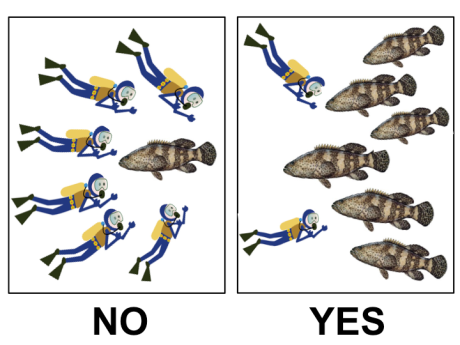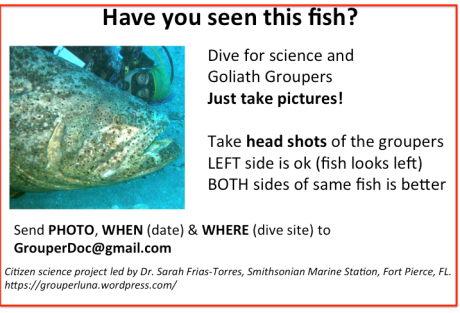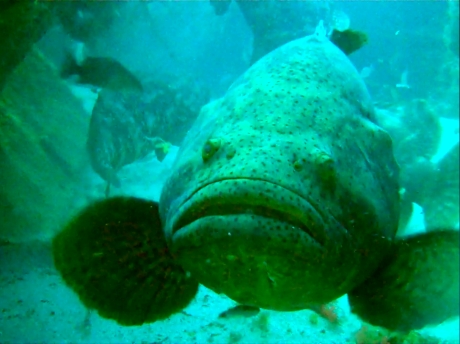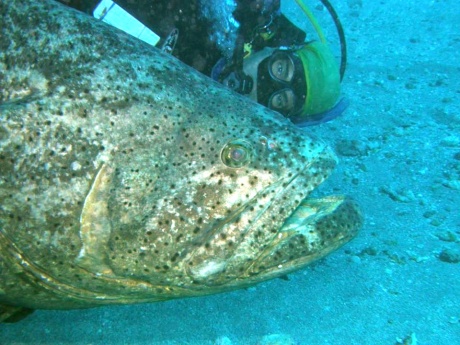This year, 2013, the critically endangered Goliath grouper is once again under review by the Florida Fish and Wildlife Conservation Commission (FWC), the Gulf of Mexico Fishery Management Council, the South Atlantic Fisheries Management Council and the National Marine Fisheries Service (NMFS) . On the table, the possibility of lifting the 1990 federal and state moratorium on harvest for this fragile species.
I have provided up-to-date information in my previous posts: Guilt-free Goliath groupers and Goliath groupers under review. Below are 5 common myths on Goliath grouper used to justify requests for lifting the current moratorium. The myths are contrasted with data obtained from scientific research done my myself and others.

PAST: Goliath groupers were fished to near extinction in the United States. Trophy fishing in the 1950s; Key West, Florida. Credit: anonymous

TODAY: Goliath grouper spawning aggregation re-forming in east Florida after being fished to extinction. Credit: Walt Stearns
Myth #1
Goliath groupers eat all the groupers, snappers and lobsters on the reef, contributing to fisheries declines.
The Science Answers: False.
In Goliath grouper, poor development of canine teeth reflects a generalized diet [1]. Analysis of stomach contents [2,3,4] reveal that diet is restricted to invertebrates, mostly shrimp and crabs, lobsters, gastropods, and poisonous or venom-spined slow-moving fish ( stingrays – Dasyatidae; cowfish – Ostraciidae; burrfish and pufferfish – Diodontidae; catfish – Ariidae). Food web dynamics based on carbon and nitrogen stable isotope analyses in goliath grouper confirm the diet preferences (invertebrates and poisonous slow moving fish) obtained through previous dentition and stomach content studies. The isotope analyses indicated a broad prey base with a relatively high trophic status [5], but not to the level of a top predatory fish as the myth explains. The most comprehensive study to date [6] demonstrates that: 1) Goliath groupers are not the cause for declining fish and lobster stocks. Overfishing is the main cause; 2) Goliath groupers function as a top-down control on juvenile lobster predators, ensuring more lobsters reach adult size and become available to the lobster fishery; and 3) goliath groupers could provide additional ecological and socioeconomic benefits: in ecotourism, and as potential bio-control of the invasive Indo-Pacific red lionfish Pterois volitans on Atlantic reefs.
Myth #2
Goliath grouper grow at a formidable speed to reach such a big size, so they must eat huge amounts of grouper, snappers and lobsters to grow that fast.
The Science Answers: False.
The goliath grouper diet is explained in myth #1. As for a formidable speed of growth, we must focus on the juvenile phase. Fish have indeterminate growth, which means, they keep increasing in length and weight throughout their life, unlike us and other mammals, who reach our maximum length (height in our case) at a determined adult age. During the juvenile phase (from birth until reaching sexual maturity), fish experience their fastest growth rate, which then decreases progressively throughout the rest of their life.
Goliath grouper juveniles migrate from their mangrove juvenile habitat to their adult reef habitat at about 8 years old, measuring 110 cm-120 cm in length [3]. This gives a maximum juvenile growth rate of 15 cm/year or 6 inches/year, as the maximum growth speed during the lifetime of an individual goliath grouper. This is the same speed at which our hair grows (!). Obviously not a mythical speed of growth.
Myth #3
Goliath grouper are a pest. They are everywhere.
The Science Answers: False.
This myth is a common problem of the “shifting baselines syndrome” [7], whereby fishers accept abundance and size information from more and more recent periods as baselines. Once commercial extinction occurred in the late 1980s, goliath grouper were absent in Florida reefs. Such absence became a new baseline, to the new anglers and spearfishers moving to Florida. Since the 1990 fishing moratorium, goliath grouper are in a path of recovery, slowly returning to their original distribution area. Therefore, every new grouper encountered represents a 100 % increase for someone with a zero-grouper baseline.
Site attachment, available habitat and spawning aggregation behavior [3,8, 9] also contribute to perceiving goliath grouper as a pest. Goliaths usually remain in the same site after they recruit to the reef. Hence the abundance of one single goliath grouper is multiplied by as many fishers or divers that have encountered it. Available hard bottom structure, specially in regions which lack natural reef habitat or where this habitat has been degraded, also concentrates goliath groupers, giving an artificial perception of over-abundance to the observer. Finally, spawning aggregations concentrate all the adult goliath grouper throughout the reef in one single location, compounding a false sense of overabundance to the casual observer. Only the few “old-timers” left in Florida, those that were fishing in the 1950s and 1960s, have experienced the extinction and path towards recovery of goliath grouper. Interestingly, these fishers are the most supportive of continued goliath grouper conservation.
Myth #4
Re-opening the fishery will provide a healthy food source for consumers.
The Science Answers: False.
We must remember that goliath grouper reached commercial extinction in the late 1980s. The species is extremely vulnerable to overfishing due to its slow growth, long life (possibly exceeding four decades), late sexual maturity (up to 8 years), strong site fidelity, the formation of spawning aggregations, and being unafraid of divers (even those with spearguns) [3,8]. Even recreational fishing could be extremely damaging as it has been demonstrated for other fish species: recreational landings in the US seriously impact many of the most-valued overfished species [10].
When the fishery existed, goliath groupers were mostly targeted for trophy fishing, that is, catching the biggest fish for show and tell. When the fish meat was used, 90 % of it was ground for fertilizer use or ended up in canned food for pets (dogs and cats). There were several reports of drugs being smuggled inside the carcasses of dead goliaths, in their way to northern states. The closure of the fishery did not result in direct starvation to any US citizen.
While it is true goliath grouper are the largest grouper fish in the Atlantic ocean, and the second largest grouper fish in the world, just behind the giant grouper of the Indo-Pacific (Epinephelus lanceolatus), big size does not necessarily translate to food source. Here, we must be concerned about health risks. Since goliath grouper are a coastal species, with a prolonged juvenile phase living in mangrove habitats, they accumulate in their tissues the pollution we generate in our modern way of living, by the effect of bioaccumulation (toxins ingested with their prey). Indeed, muscle tissue in goliath grouper commonly contain methyl mercury -a toxic form of mercury which causes dangerous cardiovascular and neurological effects in humans-, often exceeding the United States governmental advisory criteria for human health [5]. Goliath grouper also die when red tides, or Harmful Algal Blooms (HABs) from the dinoflagellate algae Karenia brevis, occur. Brevetoxin (a toxin produced by the dinoflagellate) is a potent neurotoxin that causes serious illness in humans who ingest marine life containing the toxin, or if they inhale the toxin aerosols [11]. HAB-originated fish kills in which huge numbers of goliath grouper die occur during multi-species mortality events, when manatees, dolphins and seaturtles also die. It has been demonstrated that the cause of death for the marine mammals is due to the ingestion of prey which contained the brevetoxin, and by the process of bioaccumulation, enough brevetoxin accumulated in the animal’s tissues to become the cause of death [12]. Preliminary data suggest brevetoxin accumulation is also the cause of death in goliath grouper (Frias-Torres, unpublished data). Hence, consumption of goliath grouper fillets could pose an additional brevetoxin health risk for humans. Finally, studies on pesticide levels contained in goliath grouper tissue have not been completed, but it is possible they follow a similar bioaccumulation pattern than that of methylmercury and brevetoxin.
Myth #5
There are too many goliath grouper out there. We must use this resource for the benefit of the fishermen, so we have to do something about this, such as a limited recreational take, with a tag or permit system.
The Science Answers: False.
The perception of goliath grouper invading every crevice of the reef has been discussed in myth #3, and is due to the “shifting baselines syndrome” explained there.
Spearfishers and hook-and-liners wiped out the goliath grouper population in U.S. waters in the late 1980s reaching commercial extinction [3, 13]. Goliath grouper are extremely easy to catch: they are unafraid of divers, they present site attachment (remain in the same site once they recruit to the mangroves as juveniles and to the reef as adults), and all the goliaths of the State congregate once a year at a reduced number of sites to form spawning aggregations, and reproduce. It will be extremely difficult to justify the socioeconomic, management and ethical reasons for opening a limited recreational take, mainly due to the potential health risks for human consumption (explained above), the lack of “sport” in killing such a catchable species, and the potential of localized extinction events when tags or permits were used in a short time window or limited geographic range.
A live goliath grouper is more valuable than a dead one. And here relies the true benefit for fishers and other Florida taxpayers. Tourists come from all over the country, and all over the world just to scuba dive with goliath grouper. This is a tremendous source of tourist dollars for the state of Florida, not only for the diving business – each diver pays $100-$140 for a two-tank dive, depending on gear rented-, but also for the associated businesses, as the tourist-divers need to eat, sleep, and drive. Ironically, the same qualities that make goliath grouper extremely vulnerable to overfishing and extinction, also make them a great ecotourist attraction: they are huge, long-lived, unafraid of divers, remain in the same reef site, and form spawning aggregations.
Direct benefit to fishers and the state of Florida also relies on other potential ecosystem services goliath grouper provide, specially in these times of economic and environmental crisis. The invasive Indo-Pacific lionfish (Pterois volitans) is a voracious predator of juvenile reef fish and it is causing major disruptions in Atlantic reefs, in conjunction with habitat destruction and global climate change [14]. The lack of big predators able to feed and survive the poisonous spines of lionfish favors the expansion of this invader. However, the goliath grouper’s adaptation to feed on slow-moving venom-spined or skin-poisonous fish (catfish, stingrays, cowfish, burrfish, pufferfish), could potentially become our best ally to fight against such destructive invader, and perhaps successfully preserve and rebuild Florida’s reef fish communities.
Literature Cited
[1] Smith CL. 1971. A revision of the American groupers: Epinephelus and allied genera. Bulletin of the American Museum of Natural History 146, 69-241.
[2] Bullock LH, Smith GB. 1991. Seabasses (Pisces: Serranidae). Memoirs of the Hourglass Cruises 8 (2), 1-243.
[3] Sadovy Y, Eklund AM. 1999. Synopsis of biological information on the Nassau Grouper, Epinephelus striatus (Bloch 1792), and the jewfish, E. itajara (Lichtenstein 1822). NOAA Technical Report NMFS 146, Seattle, Washington. 65 pp.
[4] Koenig CC, Coleman FC. 2009. Population density, demographics, and predation effects of adult goliath grouper (Epinephelus itajara). Final Report to NOAA MARFIN for Project NA05NMF4540045.
[5] Evers DC, Graham RT, Perkins CP, Michener R. 2009. Mercury concentration in the goliath grouper (Epinephelus itajara) of Belize: and anthropological stressor. Endang. Species Res. 7:249-256. Open Access http://www.int-res.com/articles/esr2009/7/n007p249.pdf
[6] Frias Torres, S. 2013. Should critically endangered goliath groupers, Epinephelus itajara, be culled in Florida? Oryx 47 (1): 88-95. http://journals.cambridge.org/action/displayAbstract?fromPage=online&aid=8807528
[7] Pauly D. 1995. Anecdotes and the shifting baselines syndrome in fisheries. Trends in Ecology and Evolution 10: 430.
[8] Frias-Torres S. 2006. Habitat use by juvenile goliath grouper, Epinephelus itajara, in the Florida Keys, USA. Endangered Species Research 2: 1-6. Open Access http://www.int-res.com/articles/esr2006/2/n002p001.pdf
[9] Frias-Torres S, Barroso P, Eklund A-M, Schull J, Serafy J. 2007. Activity patterns of juvenile goliath grouper, Epinephelus itajara, in a mangrove nursery. Bulletin of Marine Science 80: 587-594.
[10] Coleman FC, Figueira WF, Ueland JS, Crowder LB. 2004. The impact of United States recreational fisheries on marine fish populations. Science 305: 1958 – 1960.
[11] Steidinger KA. 1993. Algal Toxins in Seafood and Drinking Water (ed. Falconer, I.) 1-28 , Academic Press, London.
[12] Flewelling LJ and 20 authors. 2005. Red tides and marine mammal mortalities. Nature. Vol 435: 755-756
[13] McClenachan L. 2009. Historical declines of goliath grouper (Epinephelus itajara) populations of South Florida, USA. Endang. Species Res. 7:175-181. Open Access http://www.int-res.com/articles/esr2009/7/n007p175.pdf
[14] Albins MA, Hixon MA. 2008. Invasive Indo-Pacific lionfish (Pterois volitans) reduce recruitment of Atlantic coral-reef fishes. Mar Ecol. Prog. Ser., 367:233-238.
Related articles



 When you SCUBA dive in Florida, you can become a citizen scientist.
When you SCUBA dive in Florida, you can become a citizen scientist.





